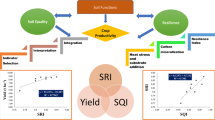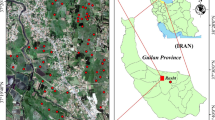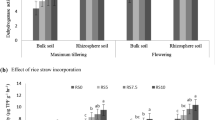Abstract
The assessment of soil quality is essential to track changes in soils as a result of management practices. Although a range of soil physical and chemical properties have been used internationally to track change in soil quality, work to evaluate a range of soil biological indicators as a means of monitoring soil quality has been more limited. In order to identify key biological indicators of soil quality, a long-term field trial at the Indian Agricultural Research Institute, New Delhi, was conducted which included tillage (main plots), water (subplots) and nutrient (sub-subplots) treatments for both rice and wheat. Here the combined influence of tillage, water and nutrient management after eight cropping cycles of rice–wheat, on selected soil microbial properties, was assessed. Results showed that non-puddling significantly enhanced dehydrogenase activity (5%), microbial biomass carbon (3%) and potentially mineralizable nitrogen (5%) over puddling, whereas the latter treatment hugely benefited soil respiration (48%) and metabolic quotient (41%) in rice. No-tillage resulted in higher values of soil biological indicators under wheat cultivation. Partial substitution of fertilizer N by farmyard manure, sewage sludge and a combination of (FYM + biofertilizer + crop residues/green manure) increased indicators at higher magnitudes, like dehydrogenase activity (36%), microbial biomass carbon (33%) and potentially mineralizable nitrogen (57%), but reduced the metabolic quotient which implied an accumulation of stable organic C under organic nutrient management uniformly after both the crops. The drainage of irrigation water in rice also increased dehydrogenase activity and microbial biomass carbon. In contrast more frequent (five times and three times) irrigations in wheat significantly increased these indicators. Principal component analysis revealed that both microbial metabolic quotient and dehydrogenase activity were the most promising indicators of soil biological quality in the present experimental setup.


Similar content being viewed by others
References
Anderson JPE (1982) Soil respiration. In: Page AL et al (eds) Methods of soil analysis. Part 2, 2nd edn. Agron. Monogr. 9. ASA and SSSA, Madison, pp 831–871
Anderson TH (1994) Physiological analysis of microbial communities in soil: applications and limitations. In: Ritz K et al (eds) Beyond the biomass. British Society of Soil Science. Wiley, New York, pp 67–76
Andrews SS, Mitchell JP, Mancinelli R, Karlen DL, Hartz TK, Horwath WR (2001) On-farm assessment of soil quality in California’s central valley. Agron J 94:12–23
Balota EL, Calegari A, Nakatani AS, Coyne MS (2014) Benefits of winter cover crops and no-tillage for microbial parameters in a Brazilian Oxisol: a long-term study. Agric Ecosyst Environ 197:31–40
Beri V, Meelu OP, Khind CS (1989) Biomass production, N accumulation, symbiotic effectiveness and mineralization of green manures in relation to yield of wetland rice. Trop Agric 66:11–16
Bernacchi CJ, Hollinger SE, Meyers T (2005) The conversion of the corn/soybean ecosystem to no-till agriculture may result in a carbon sink. Global Change Biol 11:1867–1872
Bhaduri D, Purakayastha TJ (2014) Long-term tillage, water and nutrient management in rice–wheat cropping system: assessment and response of soil quality. Soil Till Res 144:83–95
Bhaduri D, Purakayastha TJ, Patra AK, Chakraborty D (2014a) Evaluating soil quality under a long-term integrated tillage–water–nutrient experiment with intensive rice–wheat rotation in a semi-arid Inceptisol, India. Environ Monit Assess 186(4):2535–2547
Bhaduri D, Purakayastha TJ, Bhar LM, Patra AK, Sarkar B (2014b) Impact of integrated management on yield sustainability in relation to soil quality under a rice–wheat cropping system. Natl Acad Sci Lett 37(1):25–31
Brejda JJ, Karlen DL, Smith JL, Allan DL (2000) Identification of regional soil quality factors and indicators: II. Northern Mississipi loess hills and Pallouse prairie. Soil Sci Soc Am J 64:2125–2135
Chaudhury J, Mandal UK, Sharma KL, Ghosh H, Mandal B (2005) Assessing soil quality under long-term rice-based cropping system. Commun Soil Sci Plant Anal 36:1141–1161
Dick RP (1992) A review: long-term effects of agricultural systems on soils biochemical and microbial parameters. Agric Ecosyst Environ 40:25–36
Doran ZW (1987) Microbial biomass and mineralizable nitrogen distributions in no-tillage and plowed soils. Biol Fertil Soils 5:68–75
Doran JW, Parkin TB (1994) Defining and assessing soil quality. In: Doran JW et al (eds) Defining soil quality for a sustainable environment, SSSA Special Publication No. 35, SSSA and ASA, Madison, Wisconsin, USA, pp 3–21
Doran JW, Sarrantonio M, Liebig MA (1996) Soil health and sustainability. Adv Agron 56:1–54
Drinkwater LE, Letourneau DK, Worken F, van Bruggen AHC, Shennan C (1996) Fundamental differences between conventional and organic tomato agroecosystems in California. Ecol Appl 5:1098–1112
Dunteman GH (1989) Principal Components Analysis. Sage Publications, London
Eleftheriadis A, Turrión MB (2014) Soil microbiological properties affected by land use, management, and time since deforestations and crop establishment. Eur J Soil Biol 62:138–144
Feng XJ, Simpson MJ (2009) Temperature and substrate controls on microbial phospholipid fatty acid composition during incubation of grassland soils contrasting in organic matter quality. Soil Biol Biochem 41:804–812
Fuentes M, Govaerts B, De León F, Hidalgo C, Dendooven L, Sayre KD, Etchevers J (2009) Fourteen years of applying zero and conventional tillage, crop rotation and residue management systems and its effect on physical and chemical soil quality. Eur J Agron 30(3):228–237
Giacometti C, Demyan MS, Cavani L, Marzadori C, Ciavatta C, Kandeler E (2013) Chemical and microbiological soil quality indicators and their potential to differentiate fertilization regimes in temperate agroecosystems. Appl Soil Ecol 64:32–48
Govaerts B, Sayre KD, Deckers J (2006) A minimum data set for soil quality assessment of wheat and maize cropping in the highlands of Mexico. Soil Till Res 87(2):163–174
Holland EA, Coleman DC (1987) Litter placement effects on microbial and organic matter dynamics in an agroecosystem. Ecology 68:425–433
Hseu ZY, Chen ZS, Tsai CC (1999) Selected indicators and conceptual framework for assessment methods of soil quality in arable soils of Taiwan. Soil Environ 2:77–88
Hu C, Cao Z (2007) Size and activity of soil microbial biomass and soil enzyme activity in long term field experiments. World J Agric Sci 3(1):63–70
Hu J, Zhu A, Wang J, Dai J, Wang T, Chen R, Lin X (2013) Soil microbial metabolism and invertase activity under crop rotation and no-tillage in North China. Plant Soil Environ 59(11):511–516
Islam KR, Weil RR (2000) Soil quality indicator properties in mid-Atlantic soils as influenced by conservation management. J Soil Water Conserv 55(1):69–78
Jat HS, Singh G, Singh R, Choudhary M, Jat ML, Gathala MK, Sharma DK (2015) Management influence on maize–wheat system performance, water productivity and soil biology. Soil Use Manag 31(4):534–543
Jenkinson DS, Davidson SA, Powlson DS (1979) Adenosine triphosphate and microbial biomass in soil. Soil Biol Biochem 11:521–527
Kaiser HF (1960) The application of electronic computers to factor active soil organic matter pools. Soil Sci Soc Am J 58:1130–1139
Kang GS, Beri V, Sidhu BS, Rupela OP (2005) A new index to assess soil quality and sustainability of wheat-based cropping systems. Biol Fertil Soils 41:389–398
Keeney DR (1982) Nitrogen availability indices. In: Page AL, Miller RH, Keeney DR (eds) Methods of soil analysis, part 2, chemical and microbiological properties, 2nd edn. Agron. Monogr. 9, ASA and SSSA, Madison, Wisconsin, USA, pp 711–733
Klein DA, Loh TC, Goulding RL (1971) A rapid procedure to evaluate dehydrogenase activity of soils low in organic matter. Soil Biol Biochem 1:385–387
Kumar S, Patra AK, Singh D, Purakayastha TJ (2014) Long-term chemical fertilization along with farmyard manure enhances resistance and resilience of soil microbial activity against heat stress. J Agron Crop Sci 200:156–162
Lupwayi NZ, Rice WA, Clayton GW (1998) Soil microbial biomass and carbon dioxide flux under wheat as influenced by tillage and crop rotation. Cand J Soil Sci 79:273–280
Majumder B, Mandal B, Bandyopadhyay PK, GangopadhyayA Mani PK, Kundu AL, Mazumdar D (2008) Organic amendments influence soil organic carbon pools and rice–wheat productivity. Soil Sci Soc Am J 72:775–785
Mandal UK, Warrington DN, Bhardwaj AK, Bar-Tal A, Kautsky L, Minz D, Levy GJ (2008) Evaluating impact of irrigation water quality on a calcareous clay soil using principal component analysis. Geoderma 144(1):189–197
Mangalassery S, Mooney SJ, Sparkes DL, Fraser WT, Sjögersten S (2015) Impacts of zero tillage on soil enzyme activities, microbial characteristics and organic matter functional chemistry in temperate soils. Eur J Soil Biol 68:9–17
Manjaiah KM, Singh D (2001) Soil organic matter and biological properties after 26 years of maize–wheat–cowpea cropping as affected by manure and fertilization in a Cambisol in semiarid region of India. Agric Ecosyst Environ 86:155–162
Masto RE, Chhonkar PK, Singh D, Patra AK (2007) Soil quality response to long-term nutrient and crop management on a semi-arid Inceptisol. Agric Ecosyst Environ 118(1–4):130–142
Masto RE, Chhonkar PK, Purakayastha TJ, Patra AK, Singh D (2008) Soil quality indices for evaluation of long term land use and soil management practices in semi-arid sub-tropical India. Land Degrad Dev 19:1–14
Mbuthia LW, Acosta-Martinez V, De Bryun J, Schaeffer S, Tyler D, Odoi E, Mpheshea M, Walker F, Eash N (2015) Long term tillage, cover crop, and fertilization effects on microbial community structure, activity: implications for soil quality. Soil Biol Biochem 89:24–34
Murphy DV, Stockdale EA, Poulton PR, Willison TW, Goulding KWT (2007) Seasonal dynamics of carbon and nitrogen pools and fluxes under continuous arable and leyarable rotations in a temperate environment. Eur J Soil Sci 58:410–424
Nannipieri P, Greco S, Ceccanti B (1990) Ecological significance of the biological activities in soil. In: Bollog JM, Stotzky G (eds) Soil biochemistry, vol 6. Marcel Dekker Inc., New York, pp 293–355
Purakayastha TJ, Huggins DR, Smith JL (2008) Carbon sequestration in native prairie, perennial grass, no-till, and cultivated palouse silt loam. Soil Sci Soc Am J 72:534–540
Quemada M, Menacho E (2001) Soil respiration 1 year after sewage sludge application. Biol Fertil Soils 33:344–346
Reimann C, Filzmoser P, Garrett G, Dutter R (2008) Principal component analysis (PCA) and factor analysis (FA). In: Reimann C et al (eds) Statistical data analysis explained: applied environmental statistics with R, 1st edn. Wiley, Chichester, UK, pp 211–232
Rudrappa L, Purakayastha TJ, Singh D, Bhadraray S (2006) Long-term manuring and fertilization effects on soil organic carbon pools in a Typic Haplustept of semi-arid sub-tropical India. Soil Till Res 88:180–192
Sharma KL, Grace JK, Mandal UK, Gajbhiye PN, Srinivas K, Korwar GR, Bindu VH, Ramesh V, Ramachandran K, Yadav SK (2008) Evaluation of long-term soil management practices using key indicators and soil quality indices in a semi-arid tropical Alfisol. Soil Res 46(4):368–377
Singh G, Kumar D, Marwaha TS, Singh AK (2009) Influence of tillage, water regimes and integrated nitrogen management practices on soil quality indices in rice (Oryza sativa L.) in the Indo-Gangetic plains. Arch Agron Soil Sci 55(4):439–450
Singh G, Kumar D, Marwaha TS, Singh AK, Srinivasmurthy K (2011) Conservation tillage and integrated nitrogen management stimulates soil microbial properties under varying water regimes in maize–wheat cropping system in northern India. Arch Agron Soil Sci 57:507–521
Tamilselvi SM, Chinnadurai C, Ilamurugua K, Arulmozhiselvan K, Balachandar D (2015) Effect of long-term nutrient managements on biological and biochemical properties of semi-arid tropical Alfisol during maize crop development stages. Ecol Indic 48:76–87
Tao R, Liang Y, Wakelin SA, Chu G (2015) Supplementing chemical fertilizer with an organic component increases soil biological function and quality. Appl Soil Ecol 96:42–51
Tate HS, Rost DJ, Feltham CW (1988) A direct extraction method to estimate soil microbial C: effects of experimental variables and some different calibration procedures. Soil Biol Biochem 20:329–335
Vance ED, Brookes PC, Jenkinson DS (1987) An extraction method for measuring soil microbial biomass. Soil Biol Biochem 19:703–707
Wander MW, Bollero GA (1999) Soil quality assessment of tillage impacts in illinois. Soil Sci Soc Am J 63:961–971
Zhang L, Chen W, Burger M, Yang L, Gong P, Wu Z (2015) Changes in soil carbon and enzyme activity as a result of different long-term fertilization regimes in a greenhouse field. PLoS ONE 10(2):e0118371. doi:10.1371/journal.pone.0118371
Acknowledgements
First author is grateful to IARI, New Delhi, for providing Senior Research Fellowship and to Dr. A.K. Singh and all the technical staff of IARI-Mega Project. Authors also acknowledge Dr. R. Dey, ICAR-DGR for giving suitable suggestions in the manuscript.
Author information
Authors and Affiliations
Corresponding author
Rights and permissions
About this article
Cite this article
Bhaduri, D., Purakayastha, T.J., Patra, A.K. et al. Biological indicators of soil quality in a long-term rice–wheat system on the Indo-Gangetic plain: combined effect of tillage–water–nutrient management. Environ Earth Sci 76, 202 (2017). https://doi.org/10.1007/s12665-017-6513-0
Received:
Accepted:
Published:
DOI: https://doi.org/10.1007/s12665-017-6513-0




